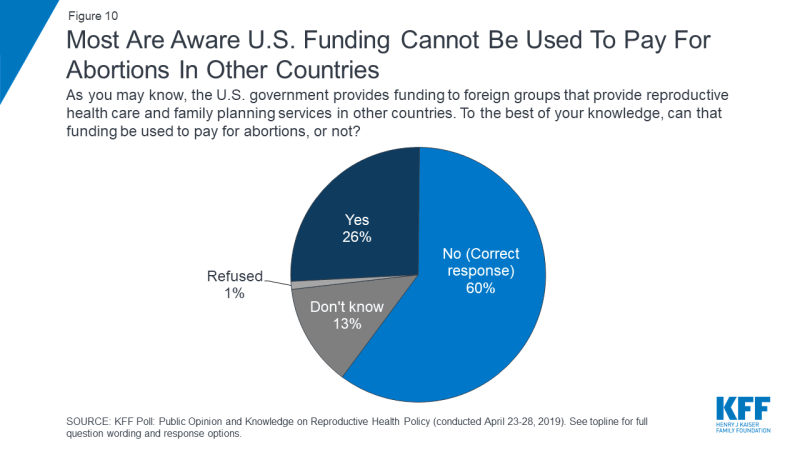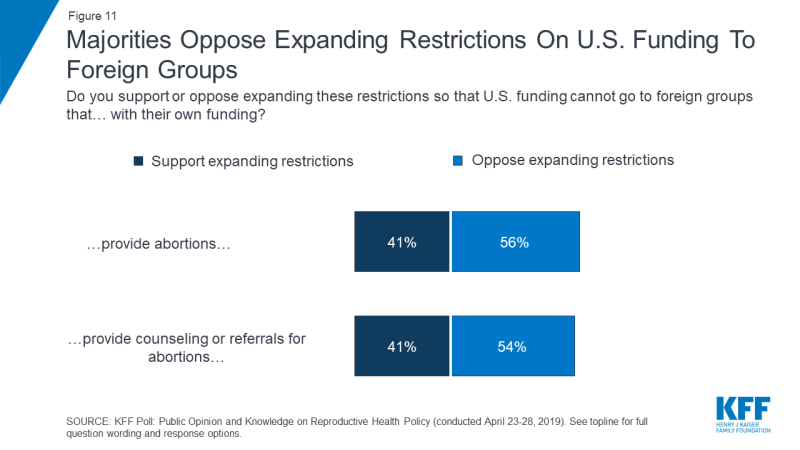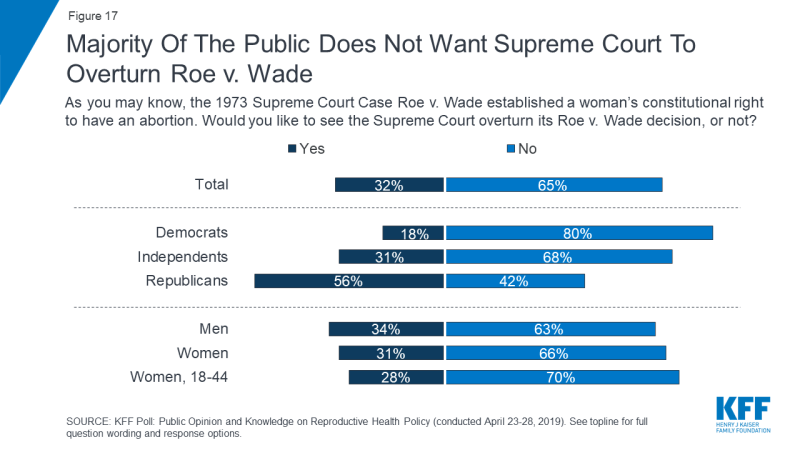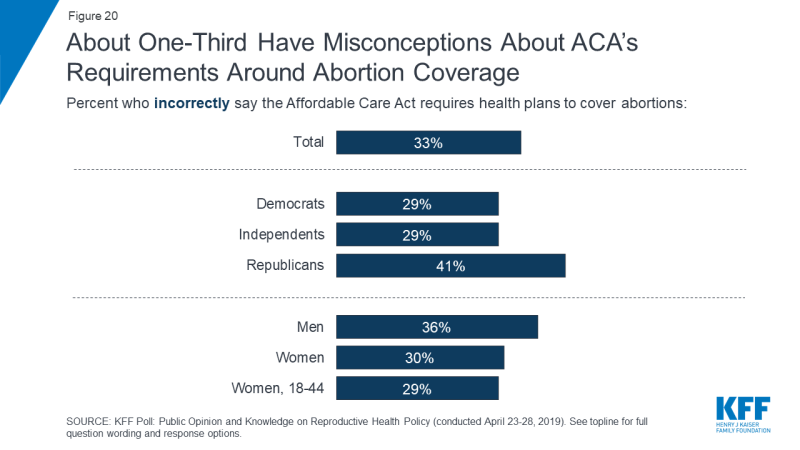KFF Poll: Public Opinion and Knowledge on Reproductive Health Policy
Kaiser Family Foundation has a long record of measuring the public’s attitudes on reproductive health care issues, including several in-depth surveys of women of reproductive age (between the ages of 18 and 44). In this poll, KFF examines public opinion towards many different facets of reproductive health care, with a focus on recent changes to federal reproductive health policy made by the Trump administration. In particular, the administration recently finalized major changes to the Title X program, which provides federal funding for family planning services for lower-income people. If implemented, these changes would prohibit federal Title X funds from going to any family planning organization that also provides abortion services or referrals. The new regulation could also channel federal family planning funds to “non-traditional” organizations that only offer natural family planning methods or promote abstinence and do not provide other contraceptive services. The implementation of the new rule was recently halted by court order, but litigation continues. The Trump administration also recently expanded the Mexico City Policy, which restricts federal funding to organizations abroad if they provide abortion services or counseling or referrals for abortions.
This poll also examines public attitudes toward laws that have been recently passed by a number of states prohibiting abortions after a fetal heartbeat has been detected and before many women even know they are pregnant. The poll continues KFF’s tracking of the public’s awareness of provisions related to women’s health that are part of the 2010 Affordable Care Act (ACA).
Key Findings:
- The poll continues to find strong support for federal government funding for reproductive health services for lower-income women, known as Title X funding. Majorities of Democrats and independents think it is important that the federal government provides this funding for lower-income women to access reproductive health services, as do a majority of Republican women (62 percent).
- Earlier this year, the Trump administration made major changes to federal rules regarding the Title X family planning program. The final rule included several changes, most notably blocking federal funding from any family planning provider that either offers or refers abortions to pregnant people – even though the federal funds do not pay for abortions. On these changes, public opinion largely falls along party lines with most Democrats and independents opposing these changes. Republicans are divided with similar shares supporting the Trump administration’s changes as opposing them. The rules have been challenged by numerous family planning organizations, providers, and state attorneys general and are currently temporarily blocked by court orders.1
- Most Americans – including three-fourths of women ages 18-44 – say they are concerned (either “very” or “somewhat”) that access to women’s reproductive health and preventive care services may be limited by the new rules that don’t allow clinics that provide abortions or refer for abortions to receive federal funding.
- The poll finds agreement across party lines on the issue of federal funding to groups that promote abstinence-only or natural family planning methods. At least half of Democrats, independents, and Republicans say they oppose federal funding going to organizations that do not provide a full array of contraceptive services. Majorities – across party identification – also oppose allowing federal funding to go to organizations that promote abstinence as the only option and do not teach young people about contraception and STD prevention.
- The poll also gauges awareness and attitudes towards restrictions on U.S. funding for foreign non-governmental organizations that provide abortions or counsel or refer for abortions, using their own funds, known as the Mexico City Policy. While the majority of the public does not support such restrictions, views diverge along partisan lines, with most Democrats and independents opposing them and most Republicans supporting the actions by the Trump administration.
- In addition to the recent Trump administration’s actions on reproductive health care, there have also been state-level activities – including passing laws banning abortions after a fetal heartbeat can be detected (normally six weeks into a pregnancy). Opinions towards this type of legislation are largely partisan with Democrats (65 percent) opposing their state passing a similar ban and Republicans supporting it (70 percent) – including three-fourths of Republican women.
- The implementation of the Affordable Care Act (ACA) had major implications for women’s health, but this survey finds there is still confusion about what the 2010 health care law actually does in terms of women’s health care. Less than half of the public are aware the ACA eliminates out-of-pocket costs for birth control (38 percent) and prohibits insurance companies from charging women more than men (36 percent).
Trump Administration and Reproductive Health Care
The Trump administration has pursued a far-reaching strategy aimed at changing the federal government’s position on domestic and international reproductive health policy. On February 22, 2019, the Department of Health and Human Services released the final rule regarding use of Title X federal funds for family planning clinics. These regulations affect nearly 4,000 clinics, which provide health care services to lower-income women in all 50 states.
Partisans Hold Differing Views towards Federal Funding Going to Organizations that Provide Both Contraception and Abortion Services
The Title X program funds clinics across the country to provide family planning services to lower-income women. The program has always prohibited federal funding to be used for abortions; but the new regulations expand these restrictions so that funding cannot go to any organizations that provide contraceptive services if they also provide abortions or refer for abortions. Majorities of the public oppose changing the regulations to exclude any organization that provides abortions (60 percent) or referrals for abortions (56 percent).
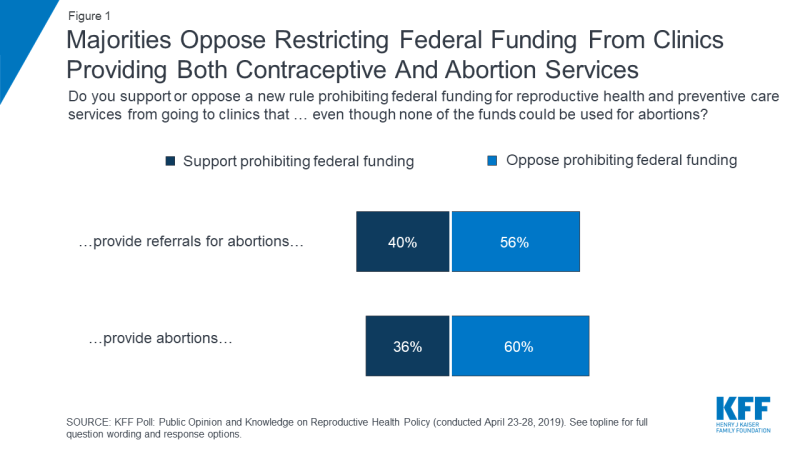
Figure 1: Majorities Oppose Restricting Federal Funding From Clinics Providing Both Contraceptive And Abortion Services
These attitudes are largely partisan with about seven in ten Democrats (68 percent) opposing the restrictions on federal funding to organizations that either provide abortions or referrals for abortions while Republicans are divided with similar shares saying they support (47 percent) and oppose (48 percent) the new rule. A larger share of independents say they oppose the new rule (57 percent) than say they support it (40 percent).
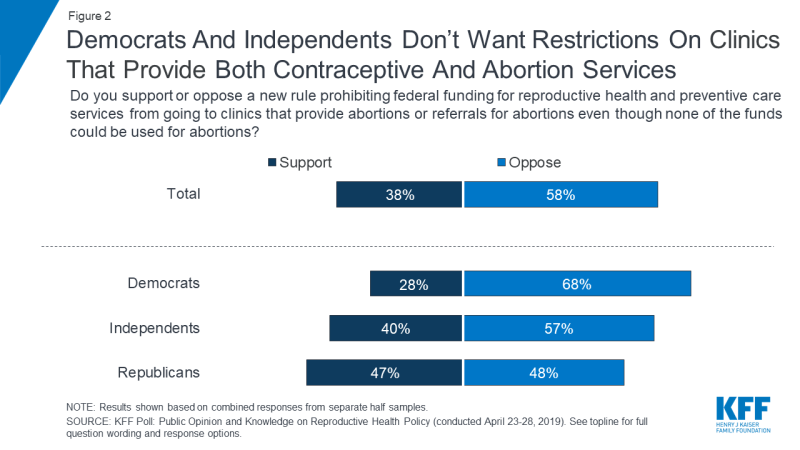
Figure 2: Democrats And Independents Don’t Want Restrictions On Clinics That Provide Both Contraceptive And Abortion Services
Public Perceptions of the Implications of Title X Rule
Overall, seven in ten (including 87 percent of Democrats, two-thirds of independents, and nearly half of Republicans) are concerned (either “very” or “somewhat”) that access to women’s reproductive health and preventive care services may be limited by the new rules that don’t allow family planning clinics that also provide abortions or refer for abortions to receive federal funding. In addition, three-fourths of women ages 18-44 (76 percent) say they are concerned that access to reproductive health and preventive care services may be limited by the new rules.
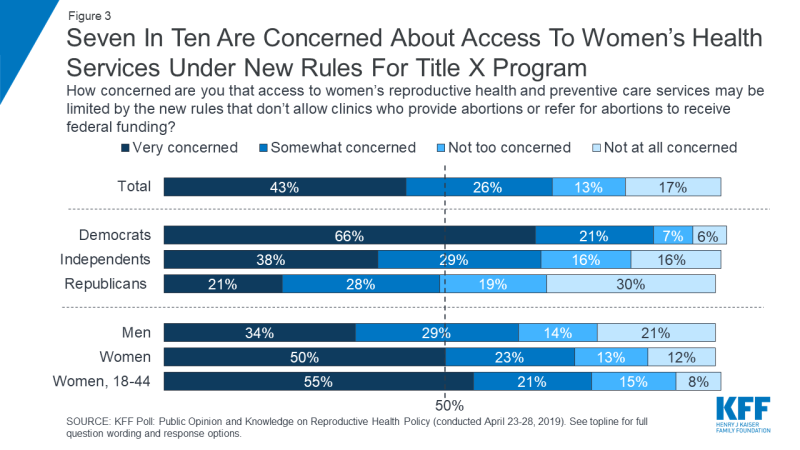
Figure 3: Seven In Ten Are Concerned About Access To Women’s Health Services Under New Rules For Title X Program
In addition, KFF continues to find strong support for federal government funding for reproductive health services for lower-income women. Three-fourths of the public say it is important (either “very” or “somewhat” that the federal government provides funding for reproductive health services including family planning and birth control for lower-income women. While a large majority of Democrats (83 percent) and six in ten independents say this is “very” important, the share is much smaller among Republicans (29 percent). This is consistent with previous KFF polling which found majorities of both women and men reporting that it is important that this funding continues.
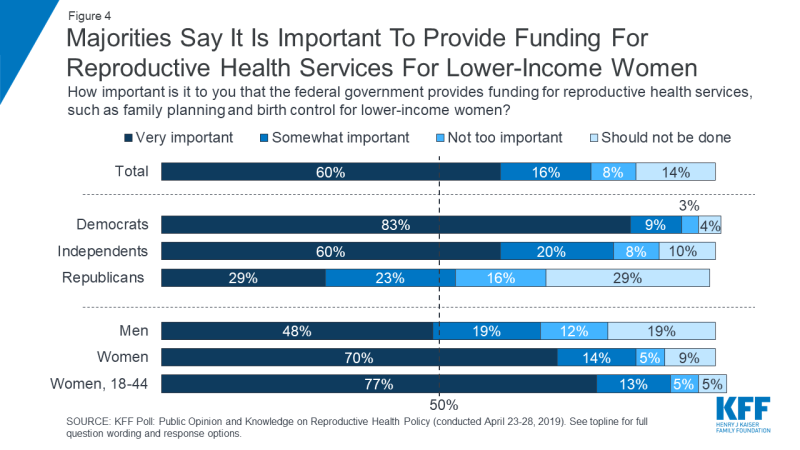
Figure 4: Majorities Say It Is Important To Provide Funding For Reproductive Health Services For Lower-Income Women
A majority of women (85 percent) say it is important the federal government provides this funding including seven in ten who say it is “very important.” Support is consistent across women with majorities of women, regardless of party identification, age, and income, saying this funding is at least somewhat important.
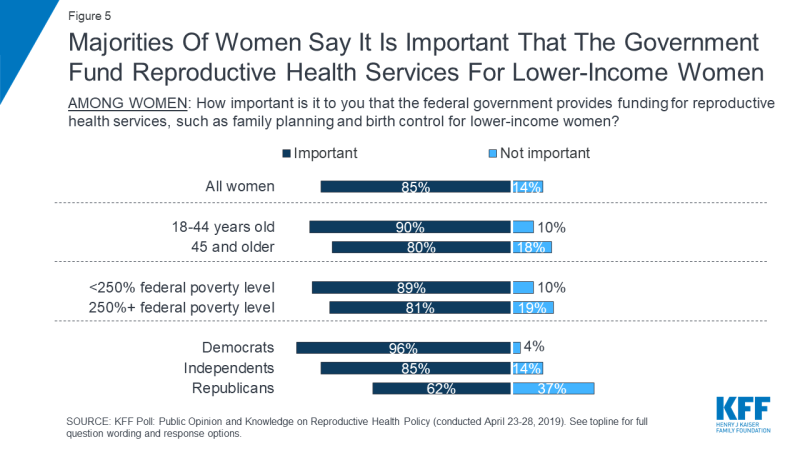
Figure 5: Majorities Of Women Say It Is Important That The Government Fund Reproductive Health Services For Lower-Income Women
Republican Women
While Republican women’s support for the Trump administration’s actions limiting federal funding from going to family planning clinics that provide abortions or referrals for abortions is similar to the support of Republican men. Republican women are more likely than their male counterparts to generally support Title X funding for reproductive health care for lower-income women. Six in ten Republican women (62 percent) say it is either “very important” or “somewhat important” the federal government provides funding for reproductive health services for lower-income women (compared to 96 percent of Democratic women, 85 percent of independent women, and 47 percent of Republican men). In addition, they are divided on whether these actions will limit access to women’s reproductive health and preventive care services. Slightly more than half (53 percent) say they are concerned that access will be limited by these new rules compared to 46 percent who say they are not concerned.
Most Oppose Allowing Federal Funding To Go To Groups That Promote Natural Family Planning or Abstinence-Only
While views towards the new rules prohibiting Title X funds from going to organizations that provide both contraceptive and abortion services are largely partisan, there is some consensus across political parties towards other changes to the Title X program.
One of the major changes in the Trump administration’s final Title X rule is removing the requirement that organizations that receive federal Title X funding must provide counseling to pregnant women that “includes abortion, adoption, and prenatal care referrals.” The new Title X regulation permits and encourages the participation of “non-traditional” organizations that only offer natural family planning (NFP) (such as fertility awareness or the rhythm method), or promote abstinence, and do not necessarily provide contraceptive services.
A majority of the public – including a majority of women – oppose these changes to the federal funding structure. About seven in ten (68 percent) oppose allowing federal funding to go to organizations that only provide counseling on NFP methods, such as the rhythm method. Two-thirds oppose (65 percent) allowing federal funding to go to organizations that do not counsel pregnant people about all of their choices, including prenatal care, adoption, and abortion; and about six in ten (59 percent) oppose federal family planning funding to support organizations that do not provide contraception or birth control.
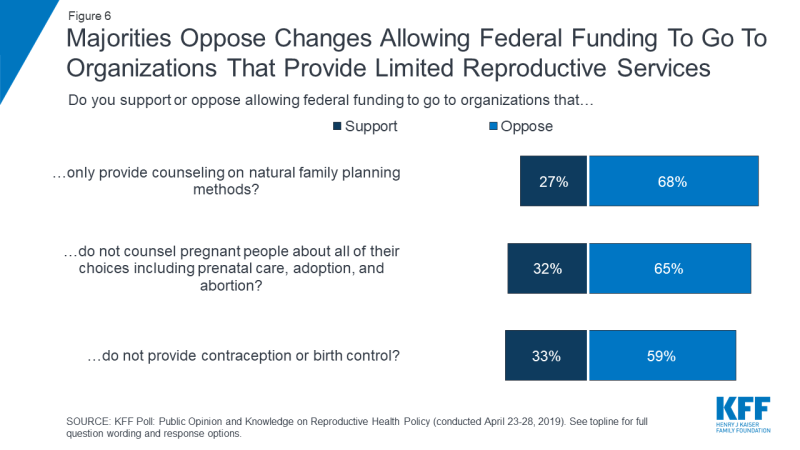
Figure 6: Majorities Oppose Changes Allowing Federal Funding To Go To Organizations That Provide Limited Reproductive Services
At least half of Democrats, independents, and Republicans say they oppose federal funding to go to organizations that do not provide a full array of reproductive health care services.
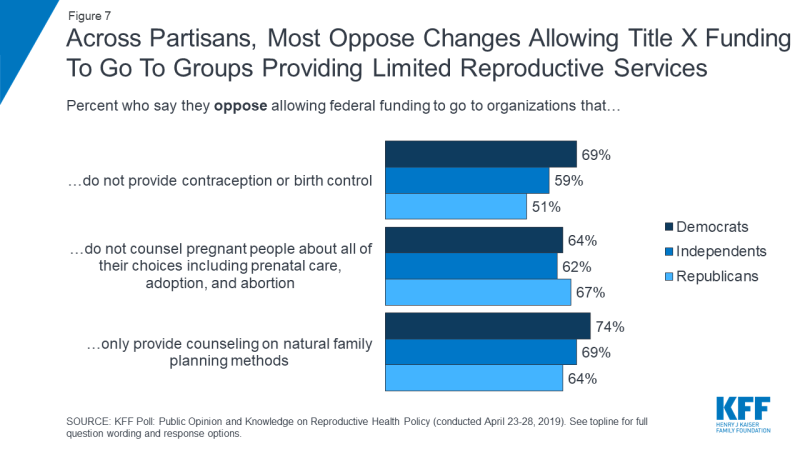
Figure 7: Across Partisans, Most Oppose Changes Allowing Title X Funding To Go To Groups Providing Limited Reproductive Services
A majority of women ages 18-44 oppose allowing federal funding to go to organizations that only provide counseling on natural family planning methods (73 percent), do not counsel pregnant people about all of their choices including prenatal care, adoption and abortion (66 percent), or do not provide contraception or birth control (64 percent).
Similarly, the public largely opposes federal funding for abstinence-only education for teenagers. The Trump administration recently announced new guidelines for funding programs to prevent teenage pregnancy. These new guidelines promote organizations that teach abstinence-only or emphasize “sexual risk avoidance.”
About seven in ten adults (72 percent) oppose allowing federal funding to go to organizations that promote abstinence as the only option and do not teach young people about contraception and STD prevention. Majorities of Democrats (77 percent) and independents (75 percent) oppose, as do a majority of Republicans (59 percent).
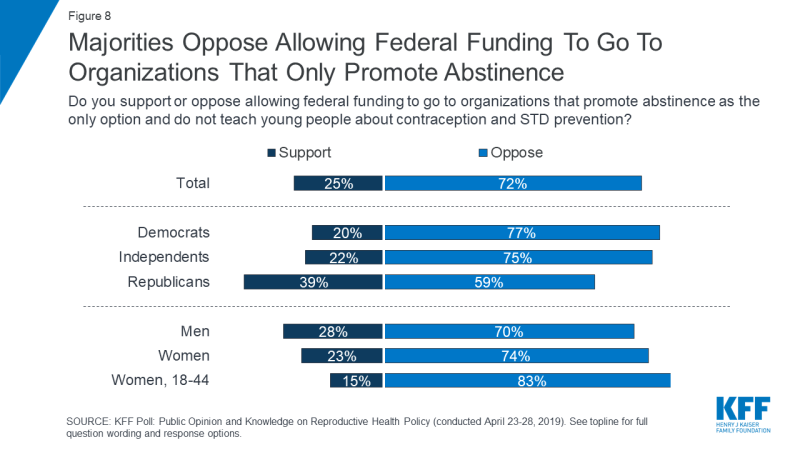
Figure 8: Majorities Oppose Allowing Federal Funding To Go To Organizations That Only Promote Abstinence
More generally, about six in ten Americans (63 percent) think teenagers should be able to get confidential health services such as STD tests, birth control, or pregnancy tests without their parent’s involvement and 61 percent say this is either “very important” or “somewhat important.” A majority of Democrats (78 percent) and independents (62 percent) and fewer Republicans (39 percent) think it is important for teenagers to be able to access these types of health services without parental involvement.
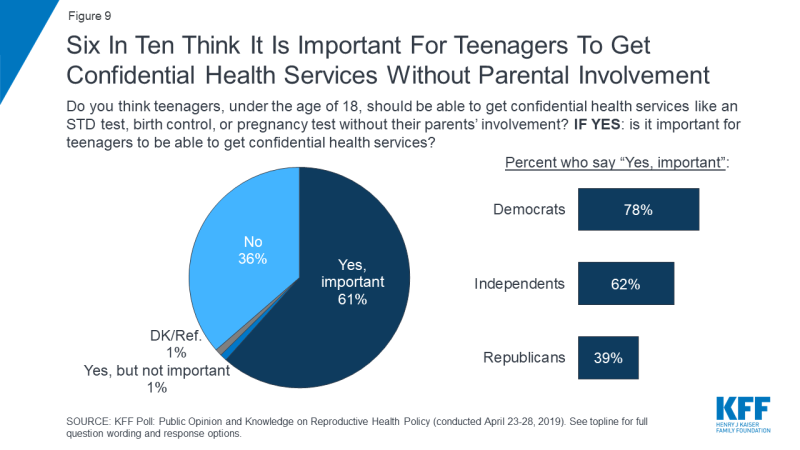
Figure 9: Six In Ten Think It Is Important For Teenagers To Get Confidential Health Services Without Parental Involvement
Mexico City Policy
While U.S. law (the Helms Amendment) restricts the use of foreign aid from paying for abortions, in early 2017, the Trump administration reinstated the Mexico City Policy, which further restricts the use of U.S. funding. Specifically, it restricts U.S. funding from going to foreign non-governmental organizations that “perform or actively promote abortion as a method of family planning” using their own money; this includes providing abortions as well as counseling and referrals for abortions. The policy, first announced by President Reagan, has been rescinded and reinstated by subsequent administrations – depending on the President’s political party. Previously, when in place under prior Republican administrations, the Mexico City Policy had only applied to foreign organizations receiving U.S. global family planning funding. The Trump administration expanded it to nearly all U.S. global health funding, greatly increasing its scope.
Overall, most (60 percent) of the public are aware that U.S. government funding to foreign groups that provide reproductive health care and family planning services cannot be used to pay for abortions although about one-fourth (26 percent) incorrectly believe it can be used to pay for abortions.
When asked whether they support or oppose the federal government expanding these restrictions so that no U.S. funding can go to foreign groups that provide abortions or counseling or referrals for abortions, even with their own funding, a larger share of the public oppose this expansion of U.S. policy than support it. More than half oppose expanding these restrictions so that U.S. funding cannot go to foreign groups that provide abortions (56 percent) or referrals for abortions (54 percent) even with their own funds. More than half of women oppose these restrictions while men are more divided.
Similar to views of domestic spending, views of international policy in this area fall along largely partisan lines. Majorities of Democrats oppose expanding restrictions on U.S. funding to any foreign group that provides ether abortions or counseling or referrals for abortions (73 percent), while most Republicans support these restrictions (64 percent). Independents are more divided with 53 percent opposing the federal government expanding these restrictions and 42 percent supporting.
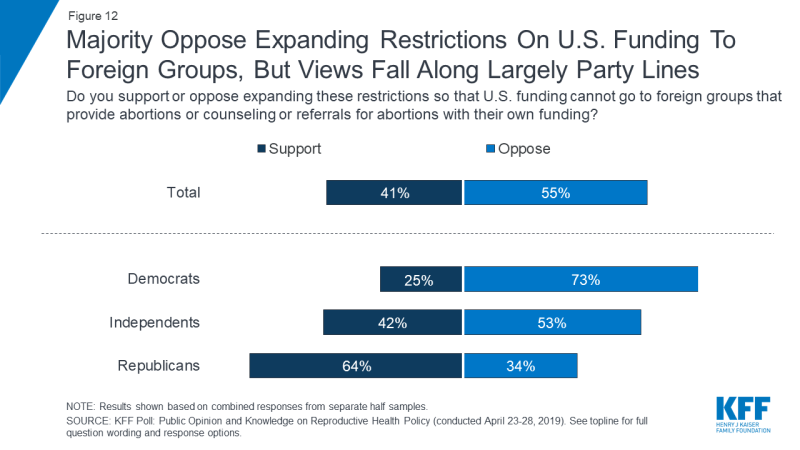
Figure 12: Majority Oppose Expanding Restrictions On Federal Funding To Foreign Groups, But Views Fall Along Largely Party Lines
Planned Parenthood
The Trump administration’s new final rule would also mean that Title X funding to Planned Parenthood, the nation’s largest family planning providers, would be blocked.2 In addition to Title X funding, Planned Parenthood clinics participate in the Medicaid program, which reimburses them for family planning services they provide to millions of lower-income people across the U.S. Nearly four in ten (38 percent) women report having ever visited a Planned Parenthood clinic.
While no federal funding to Planned Parenthood is used to pay for abortions, some states have proposed stopping all payments to Planned Parenthood for any family planning services, such as contraception or STI testing. Seven in ten (69 percent) would like their state to continue making payments to Planned Parenthood while about three in ten (29 percent) say all state payments to Planned Parenthood should be stopped. Views towards state payments to Planned Parenthood are largely partisan with nearly nine in ten Democrats (86 percent) and three-fourths of independents (74 percent) wanting to see state payments continue, while nearly six in ten Republicans (57 percent) want state payments to stop. Sizable majorities of women, overall (76 percent), and those 18-44 years old (87 percent) also support continuing state payments to Planned Parenthood. Republican women are divided with similar shares saying their state should stop payments (50 percent) as say the payment should continue (48 percent).
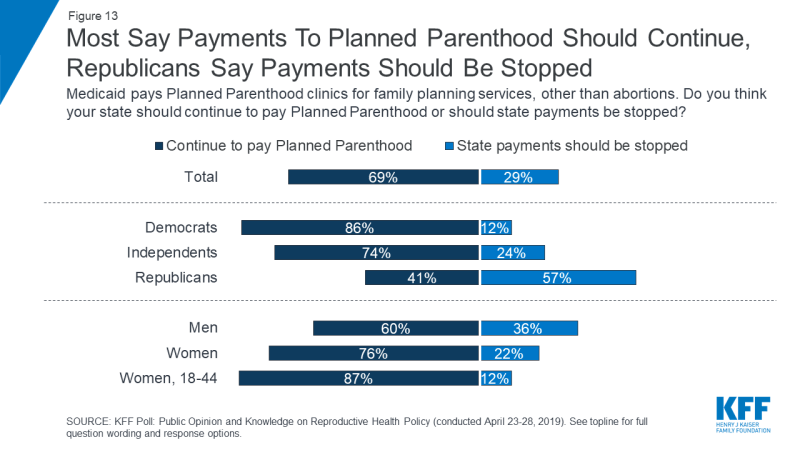
Figure 13: Most Say Payments To Planned Parenthood Should Continue, Republicans Say Payments Should Be Stopped
Attitudes towards continued state payments to Planned Parenthood seem somewhat malleable with about one-tenth of the public, on either side of the argument, changing their minds after hearing counter-arguments. For example, one-fourth (7 percent overall) change their minds and now want to see the state payments to Planned Parenthood continue after hearing that this change would make it difficult for many lower-income women to access certain health services. This brings the total share who want to see their state payments to Planned Parenthood continue up to three-fourths of the public (76 percent). On the other side of the argument, 12 percent (8 percent of overall) change their minds after hearing that while the funding does not go directly to abortions, the organization does provide or refer for abortion (bringing the share who want to see state payments stop up to 37 percent).
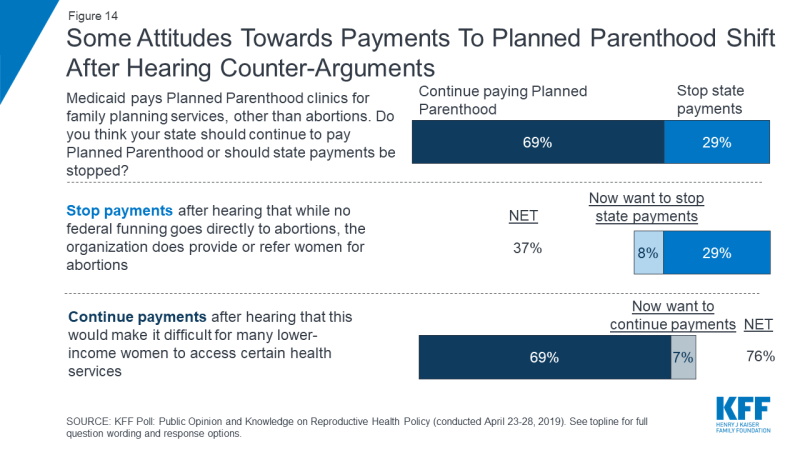
Figure 14: Some Attitudes Towards Payments To Planned Parenthood Shift After Hearing Counter-Arguments
Challenges to Roe v. Wade
In addition to the Trump administration’s actions, there have been other state-level challenges to reproductive health care access.3 For example, Ohio lawmakers recently banned abortions after a fetal heartbeat can be detected. There are similar laws in 14 other states.4
When asked about their own state passing a similar “heartbeat” ban, the public is divided with a slightly larger share supporting such a law (50 percent) while 44 percent are opposed. There are stark partisan differences with seven in ten Republicans saying they support their state passing a ban on abortions once a fetal heartbeat is detected while nearly two-thirds of Democrats (65 percent) are opposed. Independents are more divided with similar shares supporting (53 percent) and opposing (44 percent) a ban. Among women ages 18-44, about half (52 percent) oppose their state passing a law restricting abortions once a fetal heartbeat is detected while 42 percent support passing this type of law.
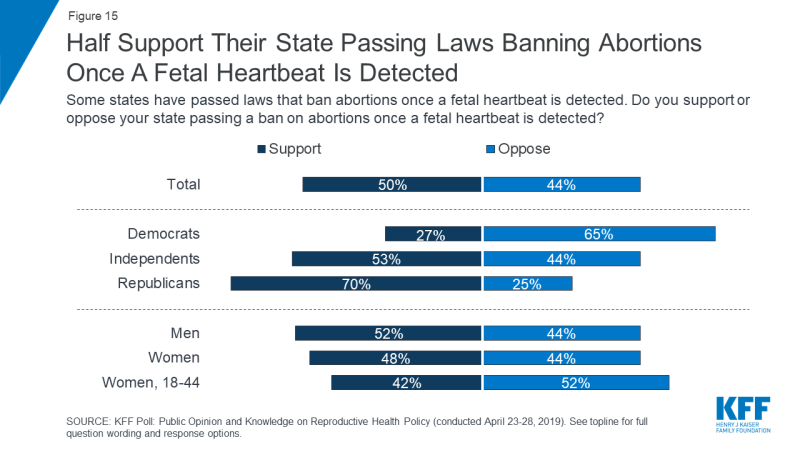
Figure 15: Half Support Their State Passing Laws Banning Abortions Once A Fetal Heartbeat Is Detected
While generally Republicans are more supportive of their state passing similar legislation, Republican women are more supportive than any other group. Three-fourths (77 percent) of Republican women support their state passing a ban on abortions once a fetal heartbeat is detected, compared to 64 percent of Republican men.
| Table 1: Republican Women Are The Group Most Supportive Of Fetal Heartbeat Bills | ||||
| Some states have passed laws that ban abortions once a fetal heartbeat is detected. Do you support or oppose your state passing a ban on abortions once a fetal heartbeat is detected? | Support | Oppose | Don’t know/ Refused | |
| Democrats | Women | 25% | 65% | 10% |
| Men | 31 | 65 | 4 | |
| Independents | Women | 53 | 44 | 3 |
| Men | 52 | 45 | 3 | |
| Republicans | Women | 77 | 16 | 7 |
| Men | 64 | 31 | 5 | |
Opponents argue that restricting abortions once a fetal heartbeat is detectable may effectively ban abortions six weeks into pregnancy and before many women know they are pregnant. About one-fourth of those who support a ban (12 percent of total) change their minds after hearing that this ban would restrict abortions before many women know they are pregnant – bringing total opposition up to 56 percent overall.
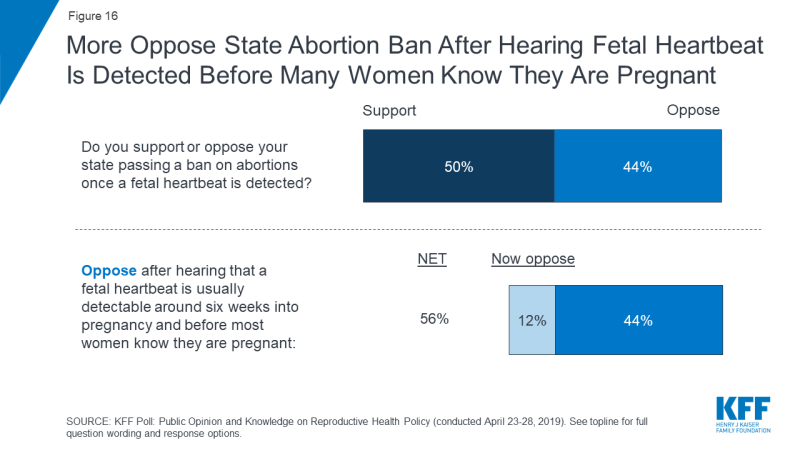
Figure 16: More Oppose State Abortion Ban After Hearing Fetal Heartbeat Is Detected Before Many Women Know They Are Pregnant
With multiple states passing bills aimed at restricting access to abortions, many legal scholars believe that the U.S. Supreme Court will be forced to take up one of these cases, thereby forcing the Court to revisit Roe v. Wade, the 1973 U.S. Supreme Court case which established a woman’s constitutional right to have an abortion. Overall, two-thirds of the public (65 percent) do not want to see the Supreme Court overturn Roe v. Wade, while about one-third (32 percent) would like to see the decision overturned.
Unsurprisingly, attitudes are largely partisan with a majority (56 percent) of Republicans wanting to see Roe v. Wade overturned, while eight in ten Democrats and about seven in ten independents (68 percent) do not want the decision overturned. Two-thirds of women overall and seven in ten women ages 18-44 say they would like to see Roe v. Wade stay in place.
If the U.S. Supreme Court overturns Roe v. Wade, it would leave the legality of abortion up to individual states5. In recent years, a number of states including Arkansas, Louisiana, North Dakota, South Dakota, and Mississippi have passed “trigger laws” which would make abortion illegal in the state if the Roe v. Wade decision is overturned. Overall, half of adults (50 percent) think abortion would continue to be legal in their state, while 42 percent think it would no longer be legal. And notably, 63 percent of those who live in states that have passed or have introduced legislation that would enact a “trigger law” think abortion would not be legal in their state if the Supreme Court overturned Roe v. Wade. Conversely, 59 percent of Americans in states which have no proposed “trigger laws” think abortion would remain legal in their states should the Supreme Court overturn the decision.6
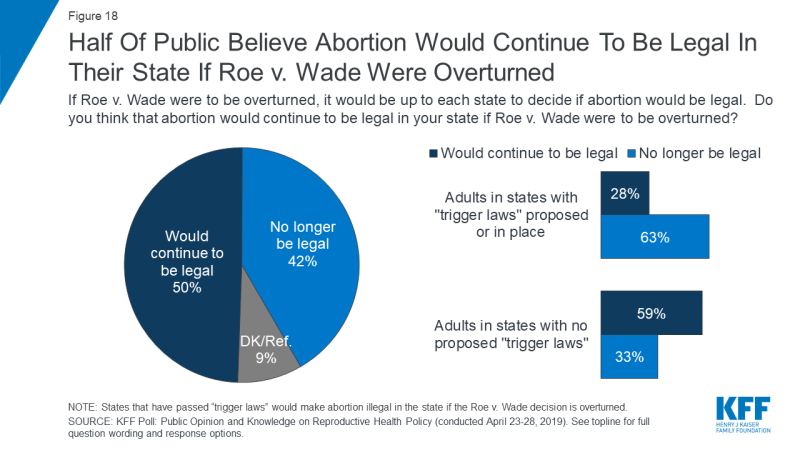
Figure 18: Half Of Public Believe Abortion Would Continue To Be Legal In Their State If Roe v. Wade Were Overturned
Public Still Largely Unaware Of Key ACA Reproductive Health Care Provisions
The implementation of the Affordable Care Act (ACA) had major implications for women’s health and access to care with requirements such as mandatory maternity care, coverage without cost-sharing for preventive services such as contraception, and a prohibition on gender rating – charging women more than men for the same coverage.7 While some changes took several years to implement, many of these requirements were implemented more than nine years ago. The poll finds there is still some confusion of what the 2010 health care law actually does. Six in ten (62 percent) are aware the law requires insurance plans purchased by individuals to include a minimum package of benefits including maternity care while about half (48 percent) are aware the law prohibits insurance companies from denying coverage based on a person’s medical history or that the law eliminates out-of-pocket costs for preventive health care services (48 percent). Less than half are aware the ACA eliminates out-of-pocket costs for birth control (38 percent) and prohibits insurance companies from charging women higher premiums than men (36 percent).
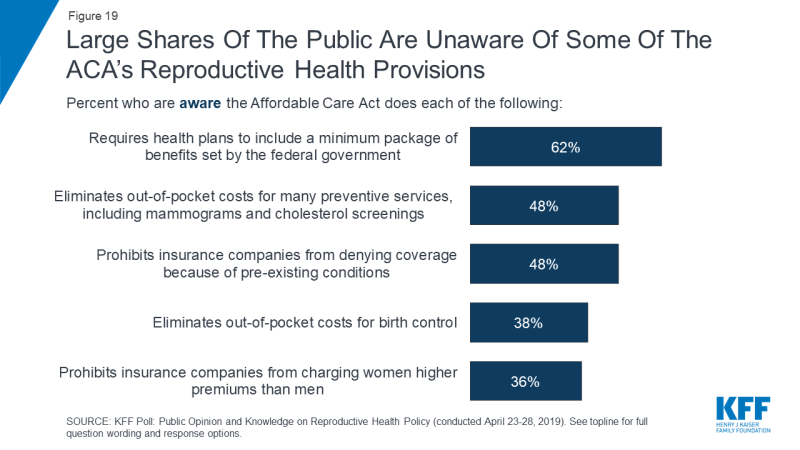
Figure 19: Large Shares Of The Public Are Unaware Of Some Of The ACA’s Reproductive Health Provisions
Overall, a larger share of women than men are aware of most of these provisions. For example, 45 percent of women overall are aware the ACA eliminated out-of-pockets for birth control (including 54 percent of women 18-44 years old) compared to three in ten men.
| Table 2: Women Are More Knowledgeable Than Men About ACA Provisions Affecting Reproductive Health Care | |||
| Percent who are aware the ACA does each of the following: | Men | Women | Women, 18-44 |
| Requires health plans to include a minimum package of benefits set by the federal government | 59% | 66% | 65% |
| Prohibits insurance companies from denying coverage because of pre-existing conditions | 43 | 53 | 48 |
| Eliminates out-of-pocket costs for many preventive services, including mammograms and cholesterol screenings | 40 | 55 | 62 |
| Prohibits insurance companies from charging women higher premiums than men | 31 | 41 | 36 |
| Eliminates out-of-pocket costs for birth control | 30 | 45 | 54 |
At the same time, misconceptions about the law remain. About one-third (33 percent) of the public incorrectly believe the ACA requires health insurance plans to cover abortions including 36 percent of men and about three in ten women overall and between the ages of 18 and 44 (29 percent). The misconception is more common among Republicans (41 percent). The ACA actually allows states to ban the sale of plans that offer abortion coverage through their ACA marketplaces and has special rules to separate the costs of abortion coverage for plans in states that still permit abortion coverage.

